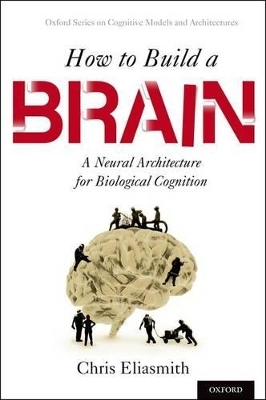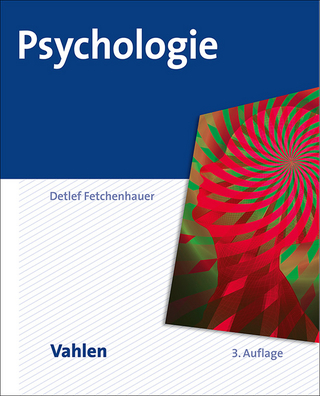
How to Build a Brain
Oxford University Press Inc (Verlag)
978-0-19-979454-6 (ISBN)
In this book, Chris Eliasmith presents a new approach to understanding the neural implementation of cognition in a way that is centrally driven by biological considerations. He calls the general architecture that results from the application of this approach the Semantic Pointer Architecture (SPA), based on the Semantic Pointer Hypothesis. According to this hypothesis, higher-level cognitive functions in biological systems are made possible by semantic pointers. These pointers are neural representations that carry partial semantic content and can be built up into the complex representational structures necessary to support cognition. The SPA architecture demonstrates how neural systems generate, compose, and control the flow of semantics pointers. Eliasmith describes in detail the theory and empirical evidence supporting the SPA, and presents several examples of its application to cognitive modeling, covering the generation of semantic pointers from visual data, the application of semantic pointers for motor control, and most important, the use of semantic pointers for representation of language-like structures, cognitive control, syntactic generalization, learning of new cognitive strategies, and language-based reasoning. He agues that the SPA provides an alternative to the dominant paradigms in cognitive science, including symbolicism, connectionism, and dynamicism.
Chris Eliasmith is Canada Research Chair in Theoretical Neuroscience at the University of Waterloo
Contents ; 1 The science of cognition ; 1.1 The last 50 years ; 1.2 How we got here ; 1.3 Where we are ; 1.4 Questions and answers ; 1.5 Nengo: An introduction ; Part I: How to build a brain ; 2 An introduction to brain building ; 2.1 Brain parts ; 2.2 A framework for building a brain ; 2.2.1 Representation ; 2.2.2 Transformation ; 2.2.3 Dynamics ; 2.2.4 The three principles ; 2.3 Levels ; 2.4 Nengo: Neural representation ; 3 Biological cognition - Semantics ; 3.1 The semantic pointer hypothesis ; 3.2 What is a semantic pointer? ; 3.3 Semantics: An overview ; 3.4 Shallow semantics ; 3.5 Deep semantics for perception ; 3.6 Deep semantics for action ; 3.7 The semantics of perception and action ; 3.8 Nengo: Neural computations ; 4 Biological cognition - Syntax ; 4.1 Structured representations ; 4.2 Binding without neurons ; 4.3 Binding with neurons. ; 4.4 Manipulating structured representations ; 4.5 Learning structural manipulations ; 4.6 Clean-up memory and scaling ; 4.7 Example: Fluid intelligence ; 4.8 Deep semantics for cognition ; 4.9 Nengo: Structured representations in neurons ; 5 Biological cognition - Control ; 5.1 The flow of information ; 5.2 The basal ganglia ; 5.3 Basal ganglia, cortex, and thalamus ; 5.4 Example: Fixed sequences of actions ; 5.5 Attention and the routing of information ; 5.6 Example: Flexible sequences of actions ; 5.7 Timing and control ; 5.8 Example: The Tower of Hanoi ; 5.9 Nengo: Question answering ; 6 Biological cognition - Memory and learning ; 6.1 Extending cognition through time ; 6.2 Working memory ; 6.3 Example: Serial list memory ; 6.4 Biological learning ; 6.5 Example: Learning new actions ; 6.6 Example: Learning new syntactic manipulations ; 6.7 Nengo: Learning ; 7 The Semantic Pointer Architecture (SPA) ; 7.1 A summary of the SPA ; 7.2 A SPA unified network ; 7.3 Tasks ; 7.3.1 Recognition ; 7.3.2 Copy drawing ; 7.3.3 Reinforcement learning ; 7.3.4 Serial working memory ; 7.3.5 Counting ; 7.3.6 Question answering ; 7.3.7 Rapid variable creation ; 7.3.8 Fluid reasoning ; 7.3.9 Discussion ; 7.4 A unified view: Symbols and probabilities ; 7.5 Nengo: Advanced modeling methods ; Part II Is that how you build a brain? ; 8 Evaluating cognitive theories 341 ; 8.1 Introduction ; 8.2 Core cognitive criteria (CCC) ; 8.2.1 Representational structure ; 8.2.1.1 Systematicity ; 8.2.1.2 Compositionality ; 8.2.1.3 Productivity ; 8.2.1.4 The massive binding problem ; 8.2.2 Performance concerns ; 8.2.2.1 Syntactic generalization ; 8.2.2.2 Robustness ; 8.2.2.3 Adaptability ; 8.2.2.4 Memory ; 8.2.2.5 Scalability ; 8.2.3 Scientific merit ; 8.2.3.1 Triangulation (contact with more sources of data) ; 8.2.3.2 Compactness ; 8.3 Conclusion ; 8.4 Nengo Bonus: How to build a brain - a practical guide ; 9 Theories of cognition ; 9.1 The state of the art ; 9.1.1 ACT-R ; 9.1.2 Synchrony-based approaches ; 9.1.3 Neural blackboard architecture (NBA) ; 9.1.4 The integrated connectionist/symbolic architecture (ICS) ; 9.1.5 Leabra ; 9.1.6 Dynamic field theory (DFT) ; 9.2 An evaluation ; 9.2.1 Representational structure ; 9.2.2 Performance concerns ; 9.2.3 Scientific merit ; 9.2.4 Summary ; 9.3 The same... ; 9.4 ...but different ; 9.5 The SPA versus the SOA ; 10 Consequences and challenges ; 10.1 Representation ; 10.2 Concepts ; 10.3 Inference ; 10.4 Dynamics ; 10.5 Challenges ; 10.6 Conclusion ; A Mathematical notation and overview ; A.1 Vectors ; A.2 Vector spaces ; A.3 The dot product ; A.4 Basis of a vector space ; A.5 Linear transformations on vectors ; A.6 Time derivatives for dynamics ; B Mathematical derivations for the NEF ; B.1 Representation ; B.1.1 Encoding ; B.1.2 Decoding ; B.2 Transformation ; B.3 Dynamics ; C Further details on deep semantic models ; C.1 The perceptual model ; C.2 The motor model ; D Mathematical derivations for the SPA ; D.1 Binding and unbinding HRRs ; D.2 Learning high-level transformations ; D.3 Ordinal serial encoding model ; D.4 Spike-timing dependent plasticity ; D.5 Number of neurons for representing structure ; E SPA model details ; E.1 Tower of Hanoi ; Bibliography ; Index
| Reihe/Serie | Oxford Series on Cognitive Models and Architectures |
|---|---|
| Verlagsort | New York |
| Sprache | englisch |
| Maße | 257 x 183 mm |
| Gewicht | 1165 g |
| Themenwelt | Geisteswissenschaften ► Psychologie ► Allgemeine Psychologie |
| Geisteswissenschaften ► Psychologie ► Verhaltenstherapie | |
| Naturwissenschaften ► Biologie ► Humanbiologie | |
| Naturwissenschaften ► Biologie ► Zoologie | |
| ISBN-10 | 0-19-979454-5 / 0199794545 |
| ISBN-13 | 978-0-19-979454-6 / 9780199794546 |
| Zustand | Neuware |
| Informationen gemäß Produktsicherheitsverordnung (GPSR) | |
| Haben Sie eine Frage zum Produkt? |
aus dem Bereich


